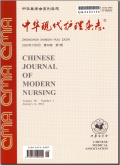冠心病监护室患者住院期间死亡风险预测模型的构建
The development of a prediction score of in-hospital death in coronary care unit patients
摘要目的 明确冠心病监护室患者住院期间死亡的危险因素并建立相应的危险评分.方法 通过河南省人民医院病案系统回顾性选取冠心病监护室2013年2月-2016年12月共1067例患者为研究对象,采用单因素及多分类Logistic回归分析确定冠心病监护室患者死亡的独立危险因素,并建立Logistic回归模型,采用受试者工作特征(ROC)曲线下面积(AUC)、Hosmer-Lemeshow拟合优度及O/E值综合判断其预测及判别性能.结果 多因素Logistic回归分析提示6个独立危险因素最终入选死亡危险评分模型并赋予相应分值如下:年龄(1分)、冠心病史(1分)、入院心功能等级(2分)、神志(1分)、收缩压(2分)、氧饱和度(2分).验证提示该评分对冠心病住院患者院内死亡的发生具有较高的辨识度及校准度(AUC为0.947、Hosmer-Lemeshow拟合优度检验P=0.995、O/E值为1.13).结论 最终建立的死亡危险评分包括6个危险因素,各因素得分为1~6分,总分为21分,<7分为低危组,7~10分为中危组,11~14分为高危组,≥15分为极高危组.该危险因素评分能够较为准确地预测冠心病监护室患者院内死亡的发生.
更多相关知识
abstractsObjective To identify the risk factors of in-hospital death in coronary care unit patients and to develop a score for relevant risks.Methods Totally 1067 patients from the coronary care unit between February 2013 and December 2016 were retrospectively selected from the medical record system of He'nan Provincial People's Hospital. The univariate and polychotomous Logistic regression analysis was used to identify the independent risk factors of death in coronary care unit patients. A Logistic regression model was built, and its performance in prediction and identification was tested by the area under the curve (AUC) of receiver operating characteristic (ROC), Hosmer-Lemeshow goodness-of-fit (GOF) and O/E value.Results According to the polychotomous Logistic regression analysis, finally six risk independent risks factors were included in the score model, and they were scored as follows: age (1), history of coronary heart disease (CHD, 1), admission cardiac function level (2), consciousness (1), systolic pressure (2) and oxygen saturation (2). The test suggested that the score's identification and calibration for the occurrence of in-hospital death among coronary care unit patients was high (AUC=0.97; Hosmer-Lemeshow GOF:P=0.995; O/E value=1.13).Conclusions The final death risk score includes six risk factors, each scored between 1 and 6, and the total score is 21. The patients scored lower than 7 is defined as the low-risk group; the patients scored between 7 and 10 is defined as the medium-risk group; the patients scored between 11 and 14 is defined as high-risk group; and the patients scored higher than 15 is defined as the extremely high-risk group. This death risk score can predict the occurrence of in-hospital death among coronary care unit patients accurately.
More相关知识
- 浏览279
- 被引4
- 下载169


相似文献
- 中文期刊
- 外文期刊
- 学位论文
- 会议论文



 换一批
换一批 换一批
换一批



